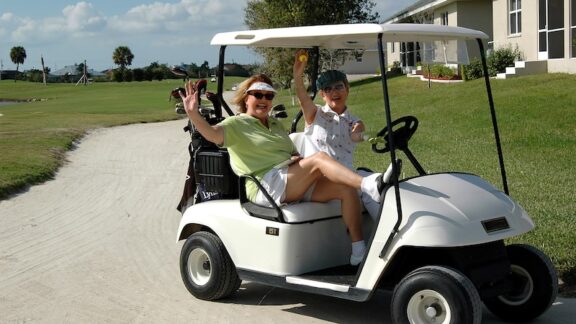Maybe you’ve heard of the term “boomerang children,” where adult kids move back in with Mom and Dad. It’s a fairly common occurrence, with approximately one-third of U.S. adult children ages 18 to 34 living with their parents in 2024, according to the US Census Bureau. Fewer people may be aware of a role reversal in home headcounts, as more parents are moving in with adult children.
Sociologists are already calling this trend the “reverse boomerang effect,” and it’s more prevalent than you might think. The data on the topic is sparse, but 9% of multi-generational U.S. homes were owned by a 25-to-34-year-old, according to the Pew Research Center. That’s up from 6% in 2001.
Why are retired moms and/or dads increasingly moving in with adult children? And is it something you might want to consider?
Experts point to some obvious and some less obvious reasons.
“The single largest cost for most people is housing, and the rising cost of housing has become prohibitive for many retirees,” said Cheryl L. Evans, director of lifetime financial security at the Milken Institute. “This is particularly significant for those living in major metropolitan areas.”
Consequently, retired parents who don’t own a home will pay much higher rents, even adjusted for inflation, than those from several decades ago.
“Many of those older parents who own a home haven’t paid off their mortgage in their early-to-mid-60s,” Evans said. “Thus, both groups face high housing costs and lower income, and moving in with relatives may be necessary or a choice that decreases their financial stress.”
There’s another reason why parents may move in with their adult kids.
“Retirees who move in with their children also benefit from social and emotional support that often contributes to their overall well-being, since loneliness becomes a big issue in retirement,” Evans added.
How to make living with adult children work for everyone
In most cases, parents and adult children agree to live under the same roof and plan out the particulars.
 “Most of the cases I have seen work well have separate or semi-separate living spaces, with the older adult typically having a private space that connects to the main house, or maybe a floor of the house,” said Frances Toler, CEO at Tolar Financial Group, in Silver Spring, Maryland.
“Most of the cases I have seen work well have separate or semi-separate living spaces, with the older adult typically having a private space that connects to the main house, or maybe a floor of the house,” said Frances Toler, CEO at Tolar Financial Group, in Silver Spring, Maryland.
“More often, a typical single-family home comes with a separate apartment in the basement, or to the side,” Tolar said. He noted that this is the option most of his clients have taken. “In most cases, the homes each had were unsuitable for this shared purpose, so they pooled resources and bought a home with an existing apartment.”
Ultimately, the living arrangements are based on three familiar factors — money, square footage, and family civility.
“If the retirees get along well with the adult kids, they can take a bedroom downstairs and be more integrated with the younger family,” said Roland Chow, partner at Optura Advisors in Burlingame, California.
If both parties mutually would like more privacy, funds can be combined to construct a so-called “granny pod” or accessory dwelling unit (ADU), which could be a living unit in the backyard, an extension of the house, or even a converted garage.
“Typically, taking a loan from the existing house to improve or extend the house is a smart move because the interest rate on the loan can be deducted,” Chow said. “The retiree can help by contributing to the cost, and it becomes a win-win for everyone, and the two or more households become a community.”
Granny pods can be limited in space, but usually have more privacy for the retiree. However, not every property can accommodate this kind of setup.
The pros and cons of living in your adult children’s homes
In most cases, parents opting to move into their adult children’s home is not the first choice for anyone. But once a decision has been made and the move is in the works, both parties should factor in the upsides and downsides.
The pros
Retirees get a good deal by moving in with an adult son or daughter.“They’ll likely have more social and family contact, more help as their abilities decline, and the ability to have a yard and garden without full responsibility,” Toler said. “Retirees can also play a big role in their grandchildren’s lives, possibly having a nicer home than they can afford.”
The adult children gain advantages too. Adult children will benefit, too, Toler said. “They’ll have the emotional support of a parent nearby and have financial help with bills.”
The adult children will also have practical support from a parent to handle complex time management issues when working, such as staying home with a sick child, having the plumber come, or walking the dog midday.
Additionally, grandparents living under the same roof (or at least on the same property) can act as built-in babysitters and easily watch the grandkids, giving mom and dad some time flexibility.
“If the adult kids have children of their own and they need babysitting help, the retiree parents would be a great resource,” Chow said.
Income flexibility for retirees. Another good option for retirees is the ability to plan for a second career or to obtain a less stressful or less time-consuming job in retirement.
“Some retirees might get a fun job, like working in a museum or park,” Evans said. “Many Americans are moving towards having multiple income streams, as the gig economy has expanded, and tech and AI are creating more online jobs. This may be enough to prevent a retiree from feeling they have no choice but to move in with someone else.”
The cons
What are the downsides of moving in with adult children?
Family conflict
Conflict may arrive sooner rather than later for families with a history of not getting along well.
“Any family with high conflict and poor communication will suffer more in close confines,” Tolar said. “It’s easy to imagine this going poorly if one party is difficult in some way. Luckily, I have not seen this yet, but have counseled clients not to proceed if they foresee lots of conflict ahead.”
That’s especially true when parents move in with their married son or daughter, who bring in-laws into the equation. Quarreling between parents and in-law spouses can easily be a deal breaker in any generational shared household scenario.
Communications and guideline issues
Live-in generational family realities can quickly erode thoughts of cozy brunches and family movie nights.
“There can be tension around boundaries, space, privacy, and generational differences,” said Lynn Toomey, founder of Her Retirement and Retired Solved, two digital retirement planning advisory platforms. “If expectations aren’t spelled out from the beginning, such as financial contributions, caregiving roles, and household responsibilities, it can certainly lead to issues.”
Additionally, caregivers, often adult daughters and daughters-in-law, may carry more of the burden, which can lead to burnout. “That’s a situation I’ve personally witnessed,” Toomey noted. “That’s why it’s so important to have a long-term plan, such as when the parent or parents need care.”
Brian O’Connell is a contributing writer at Kiplinger.com. For more on this and similar money topics, visit Kiplinger.com.
©2025 The Kiplinger Washington Editors, Inc. Distributed by Tribune Content Agency, LLC.
Read more helpful articles on Seniors Guide:
Ease the Tax Bite When You Tap Retirement Accounts




